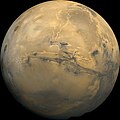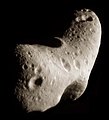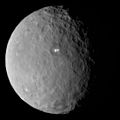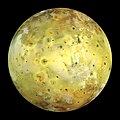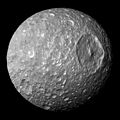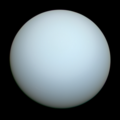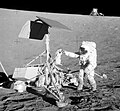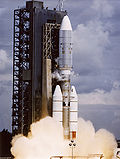ناسا
| نيشنل ايروناٽڪس ۽ اسپيس ايڊمنسٽريشن National Aeronautics and Space Administration | |
|---|---|
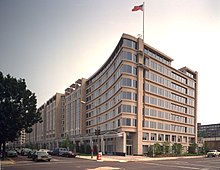 | |
| صدر دفتر | مريم ڊبليو جيڪسن ناسا هيڊ ڪوارٽر واشنگٽن ڊي سي، آمريڪا |
ايڊمنسٽريٽر |
بل نيلسن |
ڊپٽي ايڊمنسٽريٽر |
پاميلا ميلوري |
| بجيٽ | 25.4 بلين آمريڪي ڊالر(2023)
|
| ويب سائٽ | nasa.gov |
نيشنل ايروناٽڪس ۽ اسپيس ايڊمنسٽريشن، ناسا (NASA) آمريڪي وفاقي حڪومت جو هڪ آزاد ادارو آهي جيڪو سول اسپيس پروگرام، ايروناٽڪس ۽ خلائي تحقيق جو ذميوار آهي ۽ سال 1958ع ۾ قائم ٿيل نيشنل ايڊوائزري ڪميٽي فار ايروناٽڪس (NACA) جو جانشين آهي، ته جيئن آمريڪي خلائي ترقي جي ڪوشش کي هڪ الڳ شهري رخ ڏئي، خلائي سائنس ۾ پرامن ايپليڪيشنن تي زور ڏنو وڃي.[2][3][4]
هن سال 1958ع کان پوءِ آمريڪا جي اڪثر خلائي ڳولا جي پروگرامن جي اڳواڻي ڪئي آهي، جن ۾ پروجيڪٽ مرڪري، پراجيڪٽ جيميني، 1968-1972ع اپولو مون لينڊنگ مشن، اسڪائي ليب اسپيس اسٽيشن ۽ اسپيس شٽل شامل آهن. في الحال، ناسا ڪمرشل ڪريو پروگرام سان گڏ انٽرنيشنل اسپيس اسٽيشن (ISS) کي سپورٽ ڪري ٿو ۽ اورين (Orion) خلائي جهاز جي ترقي ۽ قمري آرٽميس پروگرام لاءِ خلائي لانچ سسٽم جي نگراني ڪري ٿو.
ناسا جو سائنس ڊويزن ڌرتيءَ جي مشاهدي واري نظام ذريعي ڌرتيءَ کي بهتر طور تي سمجهڻ؛ سائنس مشن ڊائريڪٽوريٽ جي هيليو فزڪس ريسرچ پروگرام جي ذريعي هيليو فزڪس کي اڳتي وڌائڻ؛ جديد روبوٽ خلائي جهازن جهڙوڪ نيو هورائزنز ۽ سياري جي روور جهڙوڪ پرسيورنس سان سڄي نظام شمسي ۾ جسمن جي ڳولا ۽ فلڪياتي فزڪس، جهڙوڪ بگ بينگ، جيمس ويب هبل اسپيس ٽيلي اسڪوپ ذريعي، جي موضوعن تي تحقيق ڪرڻ، چار عظيم آبزرويٽريز ۽ لاڳاپيل پروگرامن تي مرکوز آهي. لانچ سروسز پروگرام ان جي عملي جي بغير لانچن لاءِ لانچ آپريشن جي نگراني ڪري ٿو.
تاريخ
[سنواريو]قيام
[سنواريو]
ناسا جي جڙون نيشنل ايڊوائزري ڪميٽي فار ايروناٽڪس (NACA) سان ڳنڍيل اهن. هوائ جهاز جي جنم ڀومي هجڻ جي باوجود، سال 1914ع تائين آمريڪا تسليم ڪيو ته هو هوائ جهاز راني جي صلاحيت ۾ يورپ کان گهڻو پوئتي آهي. هوابازي ۾ آمريڪي قيادت کي ٻيهر حاصل ڪرڻ لاءِ طئي ٿيل، آمريڪي ڪانگريس سال 1914ع ۾ يو ايس آرمي سگنل ڪور جو ايوي ايشن سيڪشن ٺاهيو ۽ 1915ع ۾ نيشنل ايڊوائزري ڪميٽي فار ايروناٽڪس (NACA) قائم ڪيو ته جيئن فضائي تحقيق ۽ ترقي کي فروغ ڏئي سگهجي. ايندڙ چاليهن سالن ۾، نيشنل ايڊوائزري ڪميٽي، آمريڪي ايئر فورس، آمريڪن فوج، آمريڪن نيوي ۽ سول ايوي ايشن جي سيڪٽرن جي مدد لاء ايروناٽيڪل ريسرچ ڪندو رهيو. ٻي عالمي جنگ جي پڄاڻيءَ کان پوءِ، نيشنل ايڊوائزري ڪميٽي فار ايروناٽڪس (NACA) گائيڊڊ ميزائلن ۽ سپرسونڪ جهازن جي امڪانن ۾ دلچسپي ورتي، آمريڪي ايئر فورس سان گڏ گڏيل پروگرام ۾ بيل X-1 جي ترقي ۽ جانچ ڪئي. نيشنل ايڊوائزري ڪميٽي فار ايروناٽڪس (NACA) جي خلا ۾ دلچسپي، ان جي راڪٽري پروگرام مان، بغير پائلٽ جي ايئر ڪرافٽ ريسرچ ڊويزن سان گڏ وڌي وئي.[5]

The Soviet Union's launch of Sputnik 1 ushered in the Space Age and kicked off the Space Race. Despite NACA's early rocketry program, the responsibility for launching the first American satellite fell to the Naval Research Laboratory's Project Vanguard, whose operational issues ensured the Army Ballistic Missile Agency would launch Explorer 1, America's first satellite, on February 1, 1958.
The Eisenhower Administration decided to split the United States' military and civil spaceflight programs, which were organized together under the Defense Department's Advanced Research Projects Agency. NASA was established on July 29, 1958, with the signing of the National Aeronautics and Space Act and it began operations on October 1, 1958.[6]
As the United States' premier aeronautics agency, NACA formed the core of NASA's new structure by reassigning 8,000 employees and three major research laboratories. NASA also proceeded to absorb the Naval Research Laboratory's Project Vanguard, the Army's Jet Propulsion Laboratory (JPL), and the Army Ballistic Missile Agency under Wernher von Braun. This left NASA firmly as the United States' civil space lead and the Air Force as the military space lead.[6]
First orbital and hypersonic flights
[سنواريو]- اصل مضمون جي لاءِ ڏسو Project Mercury

Plans for human spaceflight began in the U.S. Armed Forces prior to NASA's creation. The Air Force's Man in Space Soonest project formed in 1956,[7] coupled with the Army's Project Adam, served as the foundation for Project Mercury. NASA established the Space Task Group to manage the program,[8] which would conduct crewed sub-orbital flights with the Army's Redstone rockets and orbital flights with the Air Force's Atlas launch vehicles. While NASA intended for its first astronauts to be civilians, President Eisenhower directed that they be selected from the military. The Mercury 7 astronauts included three Air Force pilots, three Navy aviators, and one Marine Corps pilot.[6]
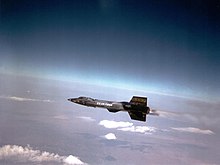
On May 5, 1961 Alan Shepard became the first American to enter space, performing a suborbital spaceflight in the Freedom 7.[9] This flight occurred less than a month after the Soviet Yuri Gagarin became the first human in space, executing a full orbital spaceflight. NASA's first orbital spaceflight was conducted by John Glenn on February 20, 1962, in the Friendship 7, making three full orbits before reentering. Glenn had to fly parts of his final two orbits manually due to an autopilot malfunction.[10] The sixth and final Mercury mission was flown by Gordon Cooper in May 1963, performing 22 orbits over 34 hours in the Faith 7.[11] The Mercury Program was wildly recognized as a resounding success, achieving its objectives to orbit a human in space, develop tracking and control systems, and identify other issues associated with human spaceflight.[6]
While much of NASA's attention turned to space, it did not put aside its aeronautics mission. Early aeronautics research attempted to build upon the X-1's supersonic flight to build an aircraft capable of hypersonic flight. The North American X-15 was a joint NASA–U.S. Air Force program,[12] with the hypersonic test aircraft becoming the first non-dedicated spacecraft to cross from the atmosphere to outer space. The X-15 also served as a testbed for Apollo program technologies, as well as ramjet and scramjet propulsion.[6]
Moon landing
[سنواريو]- اصل مضمون/مضمونن جي لاءِ ڏسو Project Gemini ۽ Apollo program

Escalations in the Cold War between the United States and Soviet Union prompted President John F. Kennedy to charge NASA with landing an American on the Moon and returning him safely to Earth by the end of the 1960s, and installed James E. Webb as NASA administrator to achieve this goal.[13] On May 25, 1961, President Kennedy openly declared this goal in his "Urgent National Needs" speech to the United States Congress, declaring:
I believe this Nation should commit itself to achieving the goal, before this decade is out, of landing a man on the Moon and returning him safely to Earth. No single space project in this period will be more impressive to mankind, or more important for the long-range exploration of space; and none will be so difficult or expensive to accomplish.
Kennedy gave his "We choose to go to the Moon" speech the next year, on September 12, 1962 at Rice University, where he addressed the nation hoping to reinforce public support for the Apollo program.[14]
Despite attacks on the goal of landing astronauts on the Moon from the former president Dwight Eisenhower and 1964 presidential candidate Barry Goldwater, President Kennedy was able to protect NASA's growing budget, of which 50% went directly to human spaceflight and it was later estimated that, at its height, 5% of Americans worked on some aspect of the Apollo program.[6]
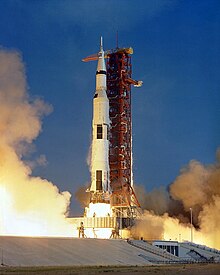
Mirroring the Department of Defense's program management concept using redundant systems in building the first intercontinental ballistic missiles, NASA requested the Air Force assign Major General Samuel C. Phillips to the space agency where he would serve as the director of the Apollo program. Development of the Saturn V rocket was led by Wernher von Braun and his team at the Marshall Space Flight Center, derived from the Army Ballistic Missile Agency's original Saturn I. The Apollo spacecraft was designed and built by North American Aviation, while the Apollo Lunar Module was designed and built by Grumman.[6]
To develop the spaceflight skills and equipment required for a lunar mission, NASA initiated Project Gemini.[15] Using a modified Air Force Titan II launch vehicle, the Gemini capsule could hold two astronauts for flights of over two weeks. Gemini pioneered the use of fuel cells instead of batteries, and conducted the first American spacewalks and rendezvous operations.

The Ranger Program was started in the 1950s as a response to Soviet lunar exploration, however most missions ended in failure. The Lunar Orbiter program had greater success, mapping the surface in preparation for Apollo landings and measured Selenography, conducted meteoroid detection, and measured radiation levels. The Surveyor program conducted uncrewed lunar landings and takeoffs, as well as taking surface and regolith observations.[6] Despite the setback caused by the Apollo 1 fire, which killed three astronauts, the program proceeded.
Apollo 8 was the first crewed spacecraft to leave low Earth orbit and the first human spaceflight to reach the Moon. The crew orbited the Moon ten times on December 24 and 25, 1968, and then traveled safely back to Earth.[16][17][18] The three Apollo 8 astronauts—Frank Borman, James Lovell, and William Anders—were the first humans to see the Earth as a globe in space, the first to witness an Earthrise, and the first to see and manually photograph the far side of the Moon.
The first lunar landing was conducted by Apollo 11. Commanded by Neil Armstrong with astronauts Buzz Aldrin and Michael Collins, Apollo 11 was one of the most significant missions in NASA's history, marking the end of the Space Race when the Soviet Union gave up its lunar ambitions. As the first human to step on the surface of the Moon, Neil Armstrong uttered the now famous words:
That's one small step for man, one giant leap for mankind.
NASA would conduct six total lunar landings as part of the Apollo program, with Apollo 17 concluding the program in 1972.[6]
End of Apollo
[سنواريو]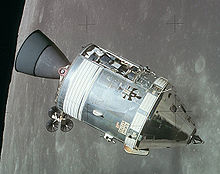
Wernher von Braun had advocated for NASA to develop a space station since the agency was created. In 1973, following the end of the Apollo lunar missions, NASA launched its first space station, Skylab, on the final launch of the Saturn V. Skylab reused a significant amount of Apollo and Saturn hardware, with a repurposed Saturn V third stage serving as the primary module for the space station. Damage to Skylab during its launch required spacewalks to be performed by the first crew to make it habitable and operational. Skylab hosted nine missions and was decommissioned in 1974 and deorbited in 1979, two years prior to the first launch of the Space Shuttle and any possibility of boosting its orbit.[6]
In 1975, the Apollo–Soyuz mission was the first ever international spaceflight and a major diplomatic accomplishment between the Cold War rivals, which also marked the last flight of the Apollo capsule.[6] Flown in 1975, a U.S. Apollo spacecraft docked with a Soviet Soyuz capsule.
Interplanetary exploration and space science
[سنواريو]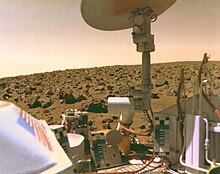
During the 1960s, NASA started its space science and interplanetary probe program. The Mariner program was its flagship program, launching probes to Venus, Mars, and Mercury in the 1960s.[19][20] The Jet Propulsion Laboratory was the lead NASA center for robotic interplanetary exploration, making significant discoveries about the inner planets. Despite these successes, Congress was unwilling to fund further interplanetary missions and NASA Administrator James Webb suspended all future interplanetary probes to focus resources on the Apollo program.[6]
Following the conclusion of the Apollo program, NASA resumed launching interplanetary probes and expanded its space science program. The first planet tagged for exploration was Venus, sharing many similar characteristics to Earth. First visited by American Mariner 2 spacecraft,[21] Venus was observed to be a hot and inhospitable planet. Follow-on missions included the Pioneer Venus project in the 1970s and Magellan, which performed radar mapping of Venus' surface in the 1980s and 1990s. Future missions were flybys of Venus, on their way to other destinations in the Solar System.[6]
Mars has long been a planet of intense fascination for NASA, being suspected of potentially having harbored life. Mariner 5 was the first NASA spacecraft to flyby Mars,[22] followed by Mariner 6 and Mariner 7. Mariner 9 was the first orbital mission to Mars. Launched in 1975, Viking program consisted of two landings on Mars in 1976. Follow-on missions would not be launched until 1996, with the Mars Global Surveyor orbiter and Mars Pathfinder, deploying the first Mars rover, Sojourner.[23] During the early 2000s, the 2001 Mars Odyssey orbiter reached the planet and in 2004 the Sprit and Opportunity rovers landed on the Red Planet. This was followed in 2005 by the Mars Reconnaissance Orbiter and 2007 Phoenix Mars lander. The 2012 landing of Curiosity discovered that the radiation levels on Mars were equal to those on the International Space Station, greatly increasing the possibility of Human exploration, and observed the key chemical ingredients for life to occur. In 2013, the Mars Atmosphere and Volatile Evolution (MAVEN) mission observed the Martian upper atmosphere and space environment and in 2018, the Interior exploration using Seismic Investigations Geodesy, and Heat Transport (InSight) studied the Martian interior. The 2021 Perseverance rover carried the first extraplanetary aircraft, a helicopter named Ingenuity.[6]

NASA also launched missions to Mercury in 2004, with the MESSENGER probe demonstrating as the first use of a solar sail.[24] NASA also launched probes to the outer Solar System starting in the 1960s. Pioneer 10 was the first probe to the outer planets, flying by Jupiter, while Pioneer 11 provided the first close up view of the planet. Both probes became the first objects to leave the Solar System. The Voyager program launched in 1977, conducting flybys of Jupiter and Saturn, Neptune, and Uranus on a trajectory to leave the Solar System.[25] The Galileo spacecraft, deployed from the Space Shuttle flight STS-34, was the first spacecraft to orbit Jupiter, discovering evidence of subsurface oceans on the Europa and observed that the moon may hold ice or liquid water.[26] A joint NASA-European Space Agency-Italian Space Agency mission, Cassini–Huygens, was sent to Saturn's moon Titan, which, along with Mars and Europa, are the only celestial bodies in the Solar System suspected of being capable of harboring life.[27] Cassini discovered three new moons of Saturn and the Huygens probe entered Titan's atmosphere. The mission discovered evidence of liquid hydrocarbon lakes on Titan and subsurface water oceans on the moon of Enceladus, which could harbor life. Finally launched in 2006, the New Horizons mission was the first spacecraft to visit Pluto and the Kuiper Belt.[6]
Beyond interplanetary probes, NASA has launched many space telescopes. Launched in the 1960s, the Orbiting Astronomical Observatory were NASA's first orbital telescopes,[28] providing ultraviolet, gamma-ray, x-ray, and infrared observations. NASA launched the Orbiting Geophysical Observatory in the 1960s and 1970s to look down at Earth and observe its interactions with the Sun. The Uhuru satellite was the first dedicated x-ray telescope, mapping 85% of the sky and discovering a large number of black holes.[6]

Launched in the 1990s and early 2000s, the Great Observatories program are among NASA's most powerful telescopes. The Hubble Space Telescope was launched in 1990 on STS-31 from the Discovery and could view galaxies 15 billion light years away.[29] A major defect in the telescope's mirror could have crippled the program, had NASA not used computer enhancement to compensate for the imperfection and launched five Space Shuttle servicing flights to replace the damaged components. The Compton Gamma Ray Observatory was launched from the Atlantis on STS-37 in 1991, discovering a possible source of antimatter at the center of the Milky Way and observing that the majority of gamma-ray bursts occur outside of the Milky Way galaxy. The Chandra X-ray Observatory was launched from the Columbia on STS-93 in 1999, observing black holes, quasars, supernova, and dark matter. It provided critical observations on the Sagittarius A* black hole at the center of the Milky Way galaxy and the separation of dark and regular matter during galactic collisions. Finally, the Spitzer Space Telescope is an infrared telescope launched in 2003 from a Delta II rocket. It is in a trailing orbit around the Sun, following the Earth and discovered the existence of brown dwarf stars.[6]
Other telescopes, such as the Cosmic Background Explorer and the Wilkinson Microwave Anisotropy Probe, provided evidence to support the Big Bang.[30] The James Webb Space Telescope, named after the NASA administrator who lead the Apollo program, is an infrared observatory launched in 2021. The James Webb Space Telescope is a direct successor to the Hubble Space Telescope, intended to observe the formation of the first galaxies.[31] Other space telescopes include the Kepler space telescope, launched in 2009 to identify planets orbiting extrasolar stars that may be Terran and possibly harbor life. The first exoplanet that the Keplar space telescope confirmed was Kepler-22b, orbiting within the habitable zone of its star.[6]
NASA also launched a number of different satellites to study Earth, such as Television Infrared Observation Satellite (TIROS) in 1960, which was the first weather satellite.[32] NASA and the United States Weather Bureau cooperated on future TIROS and the second generation Nimbus program of weather satellites. It also worked with the Environmental Science Services Administration on a series of weather satellites and the agency launched its experimental Applications Technology Satellites into geosynchronous orbit. NASA's first dedicated Earth observation satellite, Landsat, was launched in 1972. This led to NASA and the National Oceanic and Atmospheric Administration jointly developing the Geostationary Operational Environmental Satellite and discovering Ozone depletion.[6]
Space Shuttle
[سنواريو]- اصل مضمون جي لاءِ ڏسو Space Shuttle
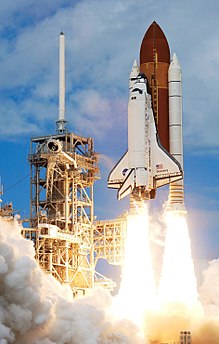
NASA had been pursuing spaceplane development since the 1960s, blending the administration's dual aeronautics and space missions. NASA viewed a spaceplane as part of a larger program, providing routine and economical logistical support to a space station in Earth orbit that would be used as a hub for lunar and Mars missions. A reusable launch vehicle would then have ended the need for expensive and expendable boosters like the Saturn V.[6]
In 1969, NASA designated the Johnson Space Center as the lead center for the design, development, and manufacturing of the Space Shuttle orbiter, while the Marshall Space Flight Center would lead the development of the launch system. NASA's series of lifting body aircraft, culminating in the joint NASA-U.S. Air Force Martin Marietta X-24, directly informed the development of the Space Shuttle and future hypersonic flight aircraft. Official development of the Space Shuttle began in 1972, with Rockwell International contracted to design the orbiter and engines, Martin Marietta for the external fuel tank, and Morton Thiokol for the solid rocket boosters.[33] NASA acquired six orbiters: the Enterprise, Columbia, Challenger, Discovery, Atlantis, and Endeavour[6]
The Space Shuttle program also allowed NASA to make major changes to its Astronaut Corps. While almost all previous astronauts were Air Force or Naval test pilots, the Space Shuttle allowed NASA to begin recruiting more non-military scientific and technical experts. A prime example is Sally Ride, who became the first American woman to fly in space on STS-7. This new astronaut selection process also allowed NASA to accept exchange astronauts from U.S. allies and partners for the first time.[6]
The first Space Shuttle flight occurred in 1981, when the Columbia launched on the STS-1 mission, designed to serve as a flight test for the new spaceplane.[34] NASA intended for the Space Shuttle to replace expendable launch systems like the Air Force's Atlas, Delta, and Titan and the European Space Agency's Ariane. The Space Shuttle's Spacelab payload, developed by the European Space Agency, increased the scientific capabilities of shuttle missions over anything NASA was able to previously accomplish.[6]
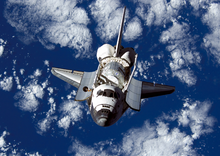
NASA launched its first commercial satellites on the STS-5 mission and in 1984, the STS-41-C mission conducted the world's first on-orbit satellite servicing mission when the Challenger captured and repaired the malfunctioning Solar Maximum Mission satellite. It also had the capability to return malfunctioning satellite to Earth, like it did with the Palapa B2 and Westar 6 satellites. Once returned to Earth, the satellites were repaired and relaunched.[6]
Despite ushering in a new era of spaceflight, where NASA was contracting launch services to commercial companies, the Space Shuttle was criticized for not being as reusable and cost-effective as advertised. In 1986, Challenger disaster on the STS-51L mission resulted in the loss of the spacecraft and all seven astronauts on launch, grounding the entire space shuttle fleet for 36 months and forced the 44 commercial companies that contracted with NASA to deploy their satellites to return to expendable launch vehicles.[35] When the Space Shuttle returned to flight with the STS-26 mission, it had undergone significant modifications to improve its reliability and safety.[6]
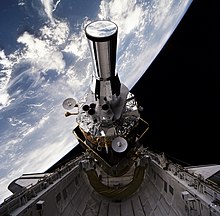
Following the collapse of the Soviet Union, the Russian Federation and United States initiated the Shuttle-Mir program.[36] The first Russian cosmonaut flew on the STS-60 mission in 1994 and the Discovery rendezvoused, but did not dock with, the Russian Mir in the STS-63 mission. This was followed by Atlantis' STS-71 mission where it accomplished the initial intended mission for the Space Shuttle, docking with a space station and transferring supplies and personnel. The Shuttle-Mir program would continue until 1998, when a series of orbital accidents on the space station spelled an end to the program.[6]
In 2003, a second space shuttle was destroyed when the Columbia was destroyed upon reentry during the STS-107 mission, resulting in the loss of the spacecraft and all seven astronauts.[37] This accident marked the beginning of the retiring of the Space Shuttle program, with President George W. Bush directing that upon the completion of the International Space Station, the space shuttle be retired. In 2006, the Space Shuttle returned to flight, conducting several mission to service the Hubble Space Telescope, but was retired following the STS-135 resupply mission to the International Space Station in 2011.
Space stations
[سنواريو]- اصل مضمون/مضمونن جي لاءِ ڏسو Space Station Freedom ۽ International Space Station

NASA never gave up on the idea of a space station after Skylab's reentry in 1979. The agency began lobbying politicians to support building a larger space station as soon as the Space Shuttle began flying, selling it as an orbital laboratory, repair station, and a jumping off point for lunar and Mars missions. NASA found a strong advocate in President Ronald Reagan, who declared in a 1984 speech:
America has always been greatest when we dared to be great. We can reach for greatness again. We can follow our dreams to distant stars, living and working in space for peaceful, economic, and scientific gain. Tonight I am directing NASA to develop a permanently manned space station and to do it within a decade.
In 1985, NASA proposed the Space Station Freedom, which both the agency and President Reagan intended to be an international program.[38] While this would add legitimacy to the program, there were concerns within NASA that the international component would dilute its authority within the project, having never been willing to work with domestic or international partners as true equals. There was also a concern with sharing sensitive space technologies with the Europeans, which had the potential to dilute America's technical lead. Ultimately, an international agreement to develop the Space Station Freedom program would be signed with thirteen countries in 1985, including the European Space Agency member states, Canada, and Japan.[6]
Despite its status as the first international space program, the Space Station Freedom was controversial, with much of the debate centering on cost. Several redesigns to reduce cost were conducted in the early 1990s, stripping away much of its functions. Despite calls for Congress to terminate the program, it continued, in large part because by 1992 it had created 75,000 jobs across 39 states. By 1993, President Bill Clinton attempted to significantly reduce NASA's budget and directed costs be significantly reduced, aerospace industry jobs were not lost, and the Russians be included.[6]

In 1993, the Clinton Administration announced that the Space Station Freedom would become the International Space Station in an agreement with the Russian Federation.[39] This allowed the Russians to maintain their space program through an infusion of American currency to maintain their status as one of the two premier space programs. While the United States built and launched the majority of the International Space Station, Russia, Canada, Japan, and the European Space Agency all contributed components. Despite NASA's insistence that costs would be kept at a budget of $17.4, they kept rising and NASA had to transfer funds from other programs to keep the International Space Station solvent. Ultimately, the total cost of the station was $150 billion, with the United States paying for two-thirds.Following the Space Shuttle Columbia disaster in 2003, NASA was forced to rely on Russian Soyuz launches for its astronauts and the 2011 retirement of the Space Shuttle accelerated the station's completion.[6]
In the 1980s, right after the first flight of the Space Shuttle, NASA started a joint program with the Department of Defense to develop the Rockwell X-30 National Aerospace Plane. NASA realized that the Space Shuttle, while a massive technological accomplishment, would not be able to live up to all its promises. Designed to be a single-stage-to-orbit spaceplane, the X-30 had both civil and military applications. With the end of the Cold War, the X-30 was canceled in 1992 before reaching flight status.[6]
Unleashing commercial space and return to the Moon
[سنواريو]- اصل مضمون/مضمونن جي لاءِ ڏسو Commercial Crew Program ۽ Artemis program
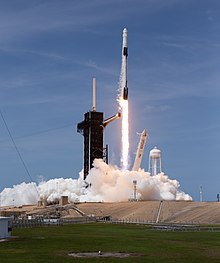
Following the Space Shuttle Columbia disaster in 2003, President Bush started the Constellation program to smoothly replace the Space Shuttle and expand space exploration beyond low Earth orbit.[40] Constellation was intended to use a significant amount of former Space Shuttle equipment and return astronauts to the Moon. This program was canceled by the Obama Administration. Former astronauts Neil Armstrong, Gene Cernan, and Jim Lovell sent a letter to President Barack Obama to warn him that if the United States did not get new human spaceflight ability, the U.S. risked become a second or third-rate space power.[6]
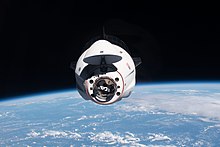
As early as the Reagan Administration, there had been calls for NASA to expand private sector involvement in space exploration rather than do it all in-house. In the 1990s, NASA and Lockheed Martin entered into an agreement to develop the Lockheed Martin X-33 demonstrator of the VentureStar spaceplane, which was intended to replace the Space Shuttle.[41] Due to technical challenges, the spacecraft was cancelled in 2001. Despite this, it was the first time a commercial space company directly expended a significant amount of its resources into spacecraft development. The advent of space tourism also forced NASA to challenge its assumption that only governments would have people in space. The first space tourist was Dennis Tito, an American investment manager and former aerospace engineer who contracted with the Russians to fly to the International Space Station for four days, despite the opposition of NASA to the idea.[6]

ناسا لاءِ هن نئين تجارتي طريقي جي حمايت ڪندڙن ۾ اڳوڻو خلاباز بز آلڊرين شامل هو، جنهن چيو ته اهو ناسا کي پنهنجي جڙڙن ڏانهن هڪ ريسرچ ۽ ڊولپمينٽ ايجنسي جي طور تي واپس آڻيندو ۽ هن وقت نجي تجارتي ادارا اصل ۾ خلائي نظام کي هلائي رهيا آهن. ڪارپوريشنز کي مداري عملن تي قبضو ڪرڻ پڻ ناسا کي، پنهنجون سموريون ڪوششون گندي خلائي ڳولا ۽ انسانن کي چنڊ ڏانهن موٽڻ ۽ مريخ ڏانهن وڃڻ جي اجازت ڏيندو. هن طريقي کي قبول ڪندي، ناسا جو تجارتي عملي جو پروگرام بين الاقوامي اسپيس اسٽيشن تي سامان پهچائڻ جو معاهدو ڪندي شروع ڪيو ۽ اسپيس-X ڪريو-1 تي پنهنجي پهرين آپريشنل معاهدي واري مشن کي اڏايو. خلائي شٽل جي ريٽائرمينٽ کان پوءِ اهو پهريون ڀيرو نشان لڳايو ويو آهي ته ناسا آمريڪا کان، هڪ آمريڪي خلائي جهاز تي پنهنجا خلاباز لانچ ڪرڻ جي قابل ٿي، روسين تي هڪ ڏهاڪي جي انحصار کي ختم ڪري ڇڏيو.[42]
سال 2019ع ۾، ناسا آرٽميس پروگرام جو اعلان ڪيو ۽ چنڊ ڏانهن موٽڻ ۽ مستقل انساني موجودگي قائم ڪرڻ جو ارادو ڪيو.[43] هن کي اتحادي ملڪنن سان آرٽيمس معاهدي سان جوڙيو ويو ته جيئن چنڊ تي خلائي ڪمرشلائيزيشن جا اصول ۽ ضابطا قائم ڪيا وڃن.[44]
سال 2023ع ۾، ناسا "چنڊ کان مارس پروگرام" آفيس قائم ڪيو. آفيس مختلف منصوبن، مشن آرڪيٽيڪچرز ۽ قمري ۽ مريخ جي ڳولا ۽ سائنس سان لاڳاپيل لاڳاپيل پروگرامن جي نگراني ڪرڻ لاء ٺهيل آهي.[45]
فعال پروگرام
[سنواريو]تعاون
[سنواريو]انتظام
[سنواريو]استحڪام
[سنواريو]ميڊيا جي موجودگي
[سنواريو]گيلري
[سنواريو]| NASA Great Observatory images | ||||||||
|---|---|---|---|---|---|---|---|---|
|
| NASA spacecraft | ||||||||||||||||||||
|---|---|---|---|---|---|---|---|---|---|---|---|---|---|---|---|---|---|---|---|---|
|
| NASA space launch systems | ||||||||||
|---|---|---|---|---|---|---|---|---|---|---|
|
| Concepts and plans | ||||||||||||||||
|---|---|---|---|---|---|---|---|---|---|---|---|---|---|---|---|---|
|
پڻ ڏسو
[سنواريو]خارجي لنڪس
[سنواريو]| وڪيميڊيا العام ۾ ناسا سان لاڳاپيل ابلاغي مواد ڏسو. |
| وڪي قول ۾ ناسا جي متعلق قول موجود آھي۔ |
| وڪي وسيلا ۾ ناسا جي متعلق وسيط موجود آھي |
- Official website

- NASA Engineering and Safety Center
- NASA History Division (archived March 2, 2000)
- Monthly look at Exploration events آرڪائيو ڪيا ويا March 8, 2021, حوالو موجود آهي وي بيڪ مشين.
- NODIS: NASA Online Directives Information System
- NTRS: NASA Technical Reports Server
- NASA History and the Challenge of Keeping the Contemporary Past
- NASA podcasts
- NASA Watch, an agency watchdog site
- How NASA works on howstuffworks.com
حوالا
[سنواريو]- ↑
"NASA's FY 2023 Budget". The Planetary Society. وقت March 24, 2023 تي اصل کان آرڪائيو ٿيل. حاصل ڪيل July 27, 2023. Unknown parameter
|url-status=ignored (مدد) - ↑ "The National Advisory Committee for Aeronautics (NACA)". web.archive.org. حاصل ڪيل 2024-09-29.
- ↑ "NASA's FY 2023 Budget". The Planetary Society. حاصل ڪيل 2024-09-29.
- ↑ "اليوم… ناسا تطلق مركبة الفضاء كرو دراجون". Shufu News (ٻولي ۾ Arabic). حاصل ڪيل 2024-09-29.
- ↑ "Naca to Nasa to Now – The frontiers of air and space in the American century" (PDF). وقت May 5, 2023 تي اصل (PDF) کان آرڪائيو ٿيل. حاصل ڪيل June 8, 2023. Unknown parameter
|url-status=ignored (مدد) - ↑ 6.00 6.01 6.02 6.03 6.04 6.05 6.06 6.07 6.08 6.09 6.10 6.11 6.12 6.13 6.14 6.15 6.16 6.17 6.18 6.19 6.20 6.21 6.22 6.23 6.24 6.25 6.26 6.27 6.28 6.29 6.30 6.31 "Naca to Nasa to Now – The frontiers of air and space in the American century" (PDF). وقت May 5, 2023 تي اصل (PDF) کان آرڪائيو ٿيل. حاصل ڪيل June 8, 2023. Unknown parameter
|url-status=ignored (مدد) - ↑ Avilla, Aeryn. "Wild Blue Yonder: USAF's Man In Space Soonest". SpaceflightHistories. حاصل ڪيل 2024-05-02.
- ↑ Grimwood, James M. (February 13, 2006). "Project Mercury – A Chronology". NASA Office of Scientific and Technical Information: 44, 45. https://spacemedicineassociation.org/videos/Project%20Mercury-A%20Chronology-NASA%20SP-4001.pdf.
- ↑ Gabriel, Angeli. "On this day in 1961: First American astronaut goes to space". Fox Weather. حاصل ڪيل 2024-05-02.
- ↑ Richard, Witkin. "Glenn Orbits Earth 3 Times Safely". archive.nytimes.com. حاصل ڪيل 2024-05-02.
- ↑ Elizabeth Howell. "Gordon Cooper: Record-Setting Astronaut in Mercury & Gemini Programs". Space.com. حاصل ڪيل 2024-05-02.
- ↑ "North American X-15 | National Air and Space Museum". airandspace.si.edu. حاصل ڪيل 2024-05-02.
- ↑ "James E. Webb". New Mexico Museum of Space History. حاصل ڪيل 2024-05-05.
- ↑ Ketterer, Samantha. "JFK's moon speech at Rice Stadium was 60 years ago. Has the U.S. lived up to it?" (en ۾). Houston Chronicle. https://www.houstonchronicle.com/news/houston-texas/space/article/JFK-Rice-moon-speech-anniversary-space-exploration-17430937.php.
- ↑ Karl Tate. "How NASA's Gemini Spacecraft Worked (Infographic)". Space.com. حاصل ڪيل 2024-05-05.
- ↑ Overbye, Dennis (December 21, 2018). "Apollo 8's Earthrise: The Shot Seen Round the World – Half a century ago today, a photograph from the moon helped humans rediscover Earth.". The New York Times. https://www.nytimes.com/2018/12/21/science/earthrise-moon-apollo-nasa.html.
- ↑ Boulton, Matthew Myer; Heithaus, Joseph (December 24, 2018). "We Are All Riders on the Same Planet – Seen from space 50 years ago, Earth appeared as a gift to preserve and cherish. What happened?". The New York Times. https://www.nytimes.com/2018/12/24/opinion/earth-space-christmas-eve-apollo-8.html.
- ↑ Widmer, Ted (December 24, 2018). "What Did Plato Think the Earth Looked Like? – For millenniums, humans have tried to imagine the world in space. Fifty years ago, we finally saw it.". The New York Times. https://www.nytimes.com/2018/12/24/opinion/plato-earth-christmas-eve-apollo-8.html.
- ↑ "Mars Mariner Missions – NASA Science". science.nasa.gov. حاصل ڪيل 2024-05-06.
- ↑ "The Mariner program". i4is.org. حاصل ڪيل 2024-05-06.
- ↑ Couch, Inez. "60 Years Since Mariner 2's Venus Flyby". Payload. حاصل ڪيل 2024-05-06.
- ↑ "Mariner 5". Laboratory for Atmospheric and Space Physics. حاصل ڪيل 2024-05-06.
- ↑ Atkinson, Stuart. "Sojourner: NASA's first Mars rover | Astronomy.com". Astronomy Magazine. حاصل ڪيل 2024-05-06.
- ↑ Yuhas, Alan (2015-05-01). "Crash course: Nasa Messenger spacecraft completes four-year mission to Mercury" (en-GB ۾). The Guardian. ISSN 0261-3077. https://www.theguardian.com/science/2015/apr/30/nasa-messenger-spacecraft-mercury-crash.
- ↑ "The Voyager missions". The Planetary Society. حاصل ڪيل 2024-05-06.
- ↑ Elizabeth Howell. "Spacecraft Galileo: To Jupiter and Its Moons". Space.com. حاصل ڪيل 2024-05-06.
- ↑ "The best places to find extraterrestrial life in our solar system, ranked". MIT Technology Review. حاصل ڪيل 2024-05-06.
- ↑ "Reaching for the stars: 50 years of space astronomy". news.wisc.edu. حاصل ڪيل 2024-05-06.
- ↑ "Hubble overview". www.esa.int. حاصل ڪيل 2024-05-06.
- ↑ "WMAP: the NASA mission that mapped the cosmic microwave background". www.skyatnightmagazine.com. حاصل ڪيل 2024-05-06.
- ↑ Specktor, Andrew MayContributions from Brandon; updated, Mindy Weisberger last. "James Webb Space Telescope: Origins, design and mission objectives". livescience.com. حاصل ڪيل 2024-05-06.
- ↑ "TIROS Meteorological Satellite | National Air and Space Museum". airandspace.si.edu. حاصل ڪيل 2024-05-06.
- ↑ "SPACE SHUTTLE PROGRAM HISTORY | Spaceline". حاصل ڪيل 2024-05-06.
- ↑ Corp, Pelmorex. "Remembering Columbia's inaugural flight – NASA's first space shuttle launch". The Weather Network. حاصل ڪيل 2024-05-06.
- ↑ McKelvie, Elizabeth HowellContributions from Callum; published, Vicky Stein. "Challenger: Shuttle Disaster That Changed NASA". Space.com. حاصل ڪيل 2024-05-06.
- ↑ "NASA and Russian space agency agree additional space shuttle/MIR missions". COSPAR Information Bulletin 1994 (129): 37–38. April 1994. doi:. ISSN 0045-8732. Bibcode: 1994CIBu..129S..37.. http://dx.doi.org/10.1016/0045-8732(94)90049-3.
- ↑ Wattles, Jackie. "How the Columbia disaster changed the future of spaceflight". CNN. حاصل ڪيل 2024-05-06.
- ↑ Leary, Warren E. (1993-06-08). "Fate of Space Station Is in Doubt As All Options Exceed Cost Goals" (en-US ۾). The New York Times. ISSN 0362-4331. https://www.nytimes.com/1993/06/08/science/fate-of-space-station-is-in-doubt-as-all-options-exceed-cost-goals.html.
- ↑ "U.S. PROPOSES SPACE MERGER WITH RUSSIA" (en-US ۾). Washington Post. 2024-01-05. ISSN 0190-8286. https://www.washingtonpost.com/archive/politics/1993/11/05/us-proposes-space-merger-with-russia/88a4b85e-ade1-4f53-9cf3-df97a5be891d/.
- ↑ "Bush sets 'new course' for moon and beyond". NBC News. حاصل ڪيل 2024-05-07.
- ↑ Bergin, Chris. "X-33/VentureStar – What really happened". NASASpaceFlight.com. حاصل ڪيل 2024-05-07.
- ↑ "Naca to Nasa to Now – The frontiers of air and space in the American century" (PDF). وقت May 5, 2023 تي اصل (PDF) کان آرڪائيو ٿيل. حاصل ڪيل June 8, 2023. Unknown parameter
|url-status=ignored (مدد) - ↑ Mann, Adam; Harvey, Ailsa. "NASA's Artemis program: Everything you need to know". Space.com. وقت April 17, 2021 تي اصل کان آرڪائيو ٿيل. حاصل ڪيل June 8, 2023. Unknown parameter
|url-status=ignored (مدد) - ↑ "NASA: Artemis Accords". NASA. وقت May 16, 2020 تي اصل کان آرڪائيو ٿيل. حاصل ڪيل June 8, 2023. Unknown parameter
|url-status=ignored (مدد) - ↑ "New Program Office Leads NASA's Path Forward for Moon, Mars – NASA". حاصل ڪيل 2024-05-14.
حوالي جي چڪ: "note" نالي جي حوالن جي لاءِ ٽيگ <ref> آهن، پر لاڳاپيل ٽيگ <references group="note"/> نہ مليو
- اھي صفحا جيڪي سانچن جي سڏن ۾ ٻٽيون شيون استعمال ڪن ٿا
- صفحا جنم ۾ غير-انگي فارميٽ.نم آرگيومينٽ آھي
- غيرمددي پيراميٽر سان حوالا تي مشتمل صفحا
- سي ايس 1 جي Arabic ٻولي جو مآخذ
- مضمون with short description
- Short description is different from Wikidata
- سان اي سي عنصر14
- VIAF سان سڃاڻپ ڪندڙ وڪيپيڊيا مضمون
- LCCN سان سڃاڻپ ڪندڙ وڪيپيڊيا مضمون
- ISNI سان سڃاڻپ ڪندڙ وڪيپيڊيا مضمون
- GND سان سڃاڻپ ڪندڙ وڪيپيڊيا مضمون
- SELIBR سان سڃاڻپ ڪندڙ وڪيپيڊيا مضمون
- BNF سان سڃاڻپ ڪندڙ وڪيپيڊيا مضمون
- BIBSYS سان سڃاڻپ ڪندڙ وڪيپيڊيا مضمون
- ULAN سان سڃاڻپ ڪندڙ وڪيپيڊيا مضمون
- MusicBrainz سان سڃاڻپ ڪندڙ وڪيپيڊيا مضمون
- NASA
- 1958 establishments in Washington, D.C.
- Articles containing video clips
- Collier Trophy recipients
- Government agencies established in 1958
- Independent agencies of the United States government
- Organizations based in Washington, D.C.
- Webby Award winners
- ناسا
- سائنسي ادارا
- حوالن ۾ چُڪَ وارا صفحا





